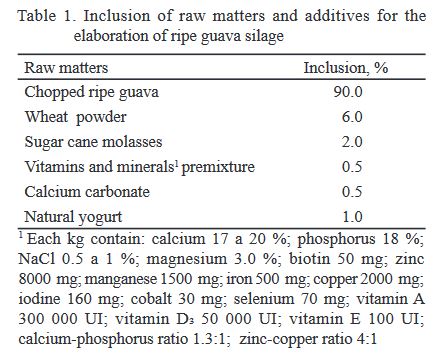Chemical characteristics of the ripe guava fruit (Psidium guajaba L.) silage for their use in pigs under the Ecuadorian Amazon conditions
Main Article Content
Abstract
At present, the conventional raw matters for the elaboration of balanced (concentration) pig diets have been notably increase, so it is necessary to use resources of alternative feeding to achieve sustainable productions. Considering the reality, the chemical characteristics of the ripe guava fruit silage as alternative food for pigs are evaluated in this study. In eight days silage samples was determined the dry matter, crude protein, crude fiber, ether extract, ashes, nitrogen free extracts and gross energy. In the days 0, 1, 4, 8, 15 and 30 the pH was determined. In the nutritional composition (dry matter, crude protein, crude fiber, ether extract, ashes, nitrogen free extracts and gross energy) the average value, standard deviation and variation coefficient was checked. The pH data were processed through a completely random design, where the treatments were the fermentation days (0, 1, 4, 8, 15 and 30 d).At day eight of evaluation; the silage has considerable contents of dry matter (22.61 %), crude protein (13.51 %), crude fiber (9.90 %), ether extract (6.08 %), ash (10.24 %), nitrogen free extract (72.49 %) and gross energy (18.54 kJ g DM-1). With respect to the pH, the highest values (p < 0.05) were showed in the day 0 (4.75) and one (4.01), and between the days 4 and 30 was stabilized (3.74-3.76). The ripe guava fruit silage showed good nutritional composition and constitutes an alternative food with favorable nutritive characteristics for their use in pig diets under the Ecuadorian Amazonia conditions.
Key words: alternative food, pigs, fermentation, tropical fruit.
Article Details
Those authors that have publications with this journal accept the following terms:
1. They will retain their copyright and guarantee the journal the right of first publication of their work, which will be simultaneously subject to the License Creative Commons Attribution-NonCommercial 4.0 International (CC BY-NC 4.0) that allows third parties to share the work whenever its author is indicated and its first publication this journal. Under this license the author will be free of:
- Share — copy and redistribute the material in any medium or format
- Adapt — remix, transform, and build upon the material
- The licensor cannot revoke these freedoms as long as you follow the license terms.
Under the following terms:
- Attribution — You must give appropriate credit, provide a link to the license, and indicate if changes were made. You may do so in any reasonable manner, but not in any way that suggests the licensor endorses you or your use.
- NonCommercial — You may not use the material for commercial purposes.
- No additional restrictions — You may not apply legal terms or technological measures that legally restrict others from doing anything the license permits.
2. The authors may adopt other non-exclusive license agreements to distribute the published version of the work (e.g., deposit it in an institutional telematics file or publish it in a monographic volume) whenever the initial publication is indicated in this journal.
3. The authors are allowed and recommended disseminating their work through the Internet (e.g. in institutional telematics archives or on their website) before and during the submission process, which can produce interesting exchanges and increase the citations of the published work. (See the Effect of open access).
References
AOAC (Association of Official Analytical Chemists). 2005. Official Method of Analysis. 18th Ed. Ed. Association of Official Analytical Chemists, Inc. Gaithersburg MD, USA, ISBN: 978-0-935584-87-5.
Álvarez, S., Méndez, P. & Martínez-Fernández, A. 2015. "Fermentative and nutritive quality of banana by-product silage for goats". Journal of Applied Animal Research, 43(4): 396-401, ISSN: 0971-2119. https://doi.org/10.1080/09712119.2014.978782.
Ávila, C.L.S. & Carvalho, B.F. 2020. "Silage fermentation - updates focusing on the performance of micro-organisms". Journal of Applied Microbiology, 128(4): 966-984, ISSN: 1364-5072. https://doi.org/10.1111/jam.14450.
